1995 CHEVROLET CAMARO tires
[x] Cancel search: tiresPage 231 of 388
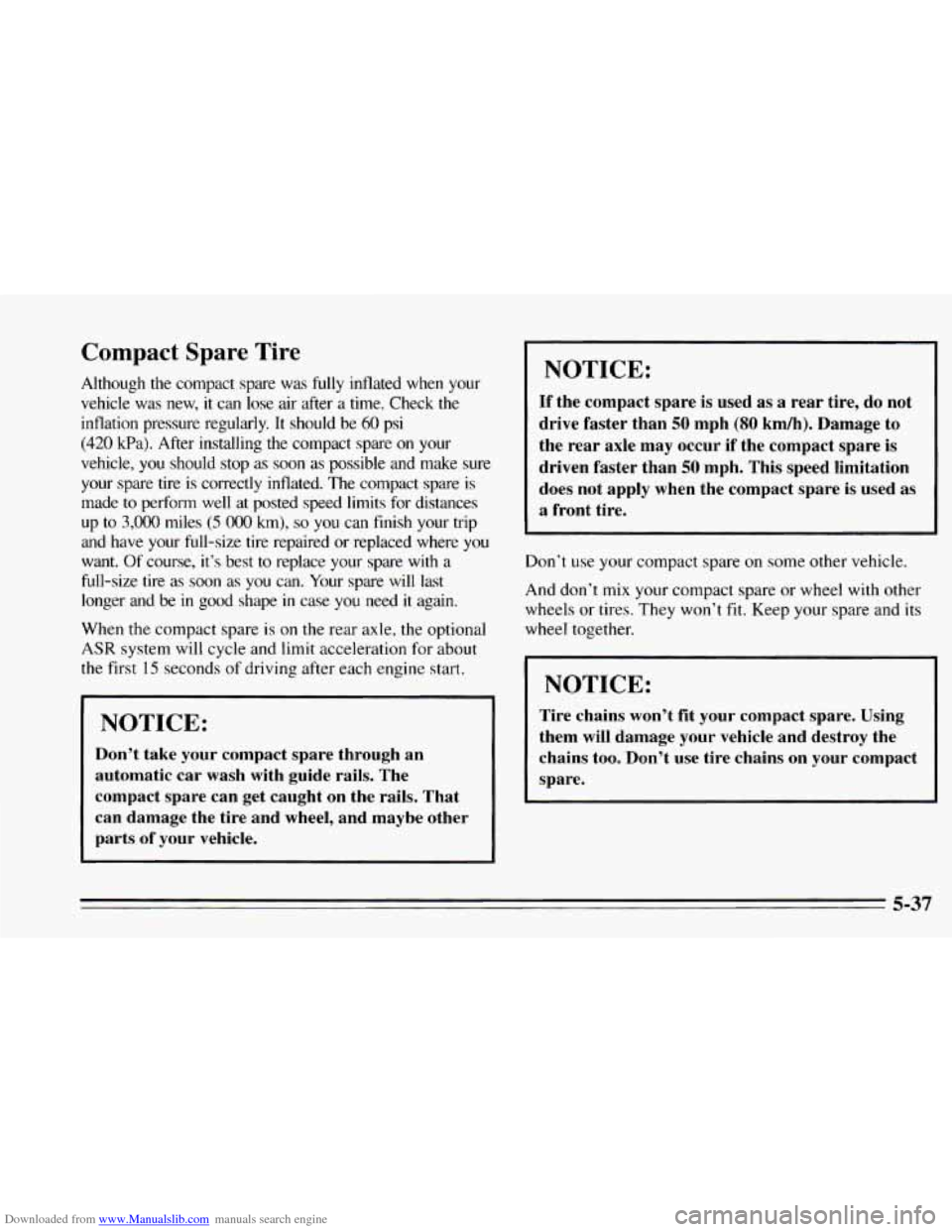
Downloaded from www.Manualslib.com manuals search engine Compact Spare Tire
Although the compact spare was fully inflated when your
vehicle was new,
it can lose air after a time. Check the
inflation pressure regularly. It should be
60 psi
(420 kPa). After installing the compact spare on your
vehicle, you should stop as soon
as possible and make sure
your spare tire is correctly inflated.
The compact spare is
made
to perform well at posted speed limits for distances
up
to 3,000 miles (5 O00 km), so you can finish your trip
and have your full-size tire repaired or replaced where
you
want. Of course, it’s best to replace your spare with a
full-size tire as soon as you
can. Your spare will last
longer and be
in good shape in case you need it again.
When the compact spare is
on the rear axle, the optional
ASR system will cycle and limit acceleration for about
the first 15 seconds of driving after each engine start.
NOTICE:
Don’t take your compact spare through an
automatic car wash
with guide rails. The
compact spare can get caught on the rails. That
can damage the tire and wheel, and maybe other
parts
of your vehicle.
I
I NOTICE:
If the compact spare is used as a rear tire, do not
drive faster than
50 mph (80 km/h). Damage to
the rear axle may occur if the compact spare
is
driven faster than 50 mph. This speed limitation
does not apply when the compact spare is used
as
a front tire.
Don’t use your compact spare
on some other vehicle.
And don’t mix your compact spare or wheel with other
wheels or tires. They won’t fit. Keep your spare and its
wheel together.
I NOTICE:
Tire chains won’t fit your compact spare. Using
them will damage your vehicle and destroy the
chains too. Don’t use tire chains
on your compact
spare.
5-37
Page 232 of 388

Downloaded from www.Manualslib.com manuals search engine If You’re Stuck: In Sand, Mud, Ice or
Snow
What you don’t want to do when your vehicle is stuck is
to spin your wheels too fast. The method known as
“rocking” can help you get out when you’re stuck,
but
you must use caution.
I NOTICE:
Spinning your wheels can destroy parts of your
vehicle as well as the tires. If you spin the wheels
too fast while shifting your transmission back
and forth, you can destroy your transmission.
For information about using tire chains on your vehicle,
see “Tire Chains” in the Index.
Rocking your vehicle to get it out:
First, turn your steering wheel left and right. That will
clear the area around your front wheels.
If your vehicle
has ASR, you should
turn the system off. (See “ASR
System” in the Index.) Then shift back and forth
between REVERSE
(R) and a forward gear (or
with
a manual transmission, between FIRST (1) or
SECOND
(2) gear and REVERSE), spinning the wheels
as little as possible. Release the accelerator pedal while
you shift, and press lightly on the accelerator pedal
when the transmission
is in gear. If that doesn’t get you
out after a few tries, you may need to be towed out.
If
you do need to be towed out, see “Towing Your Car”
in the Index.
Page 269 of 388
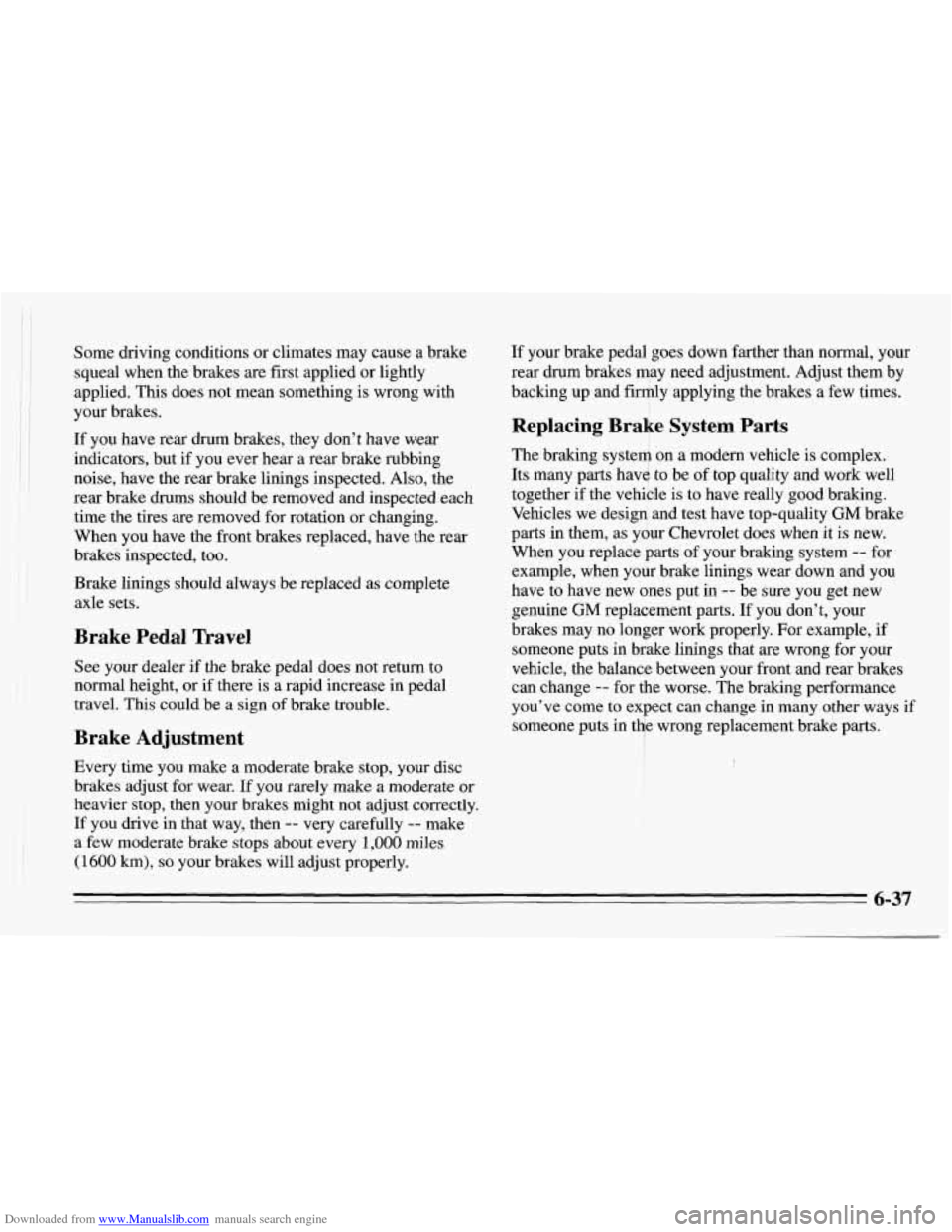
Downloaded from www.Manualslib.com manuals search engine Some driving conditions or climates may cause a brake
squeal when the brakes are first applied or lightly
applied. This does not mean something is wrong with
your brakes.
If you have rear drum brakes, they don’t have wear
indicators, but
if you ever hear a rear brake rubbing
noise, have the rear brake linings inspected. Also, the
rear brake drums should be removed and inspected each
time the tires are removed for rotation or changing.
When you have the front brakes replaced, have the rear
brakes inspected, too.
Brake linings should always be replaced as complete
axle sets.
Brake Pedal Travel
See your dealer if the brake pedal does not return to
normal height, or
if there is a rapid increase in pedal
travel. This could be
a sign of brake trouble.
Brake Adjustment
Every time you make a moderate brake stop, your disc
brakes adjust for wear. If you rarely make a moderate or
heavier stop, then your brakes might not adjust correctly.
If you drive in that way, then -- very carefully -- make
a few moderate brake stops about every 1,000
miles
(1600 km), so your brakes will adjust properly. If
your brake pedal goes down farther than normal, your
rear drum brakes may need adjustment. Adjust them by
backing up and firmly applying the brakes a few times.
Replacing Brake System Parts
The braking system on a modern vehicle is complex.
Its many parts have: to be of top quality and work well
together if the vehicle is to have really good braking.
Vehicles we design and test have top-quality
GM brake
parts in them, as your Chevrolet does when it is new.
When
you replace parts of your braking system -- for
example, when your brake linings wear down and you
have to have new ones put
in -- be sure you get new
genuine
GM replacement parts. If you don’t, your
brakes may no longer work properly. For example,
if
someone puts in brake linings that are wrong for your
vehicle, the balance between your front and rear brakes
can change
-- for the worse. The braking performance
you’ve come
to expect can change in many other ways if
someone puts in t+ wrong replacement brake parts.
Page 271 of 388
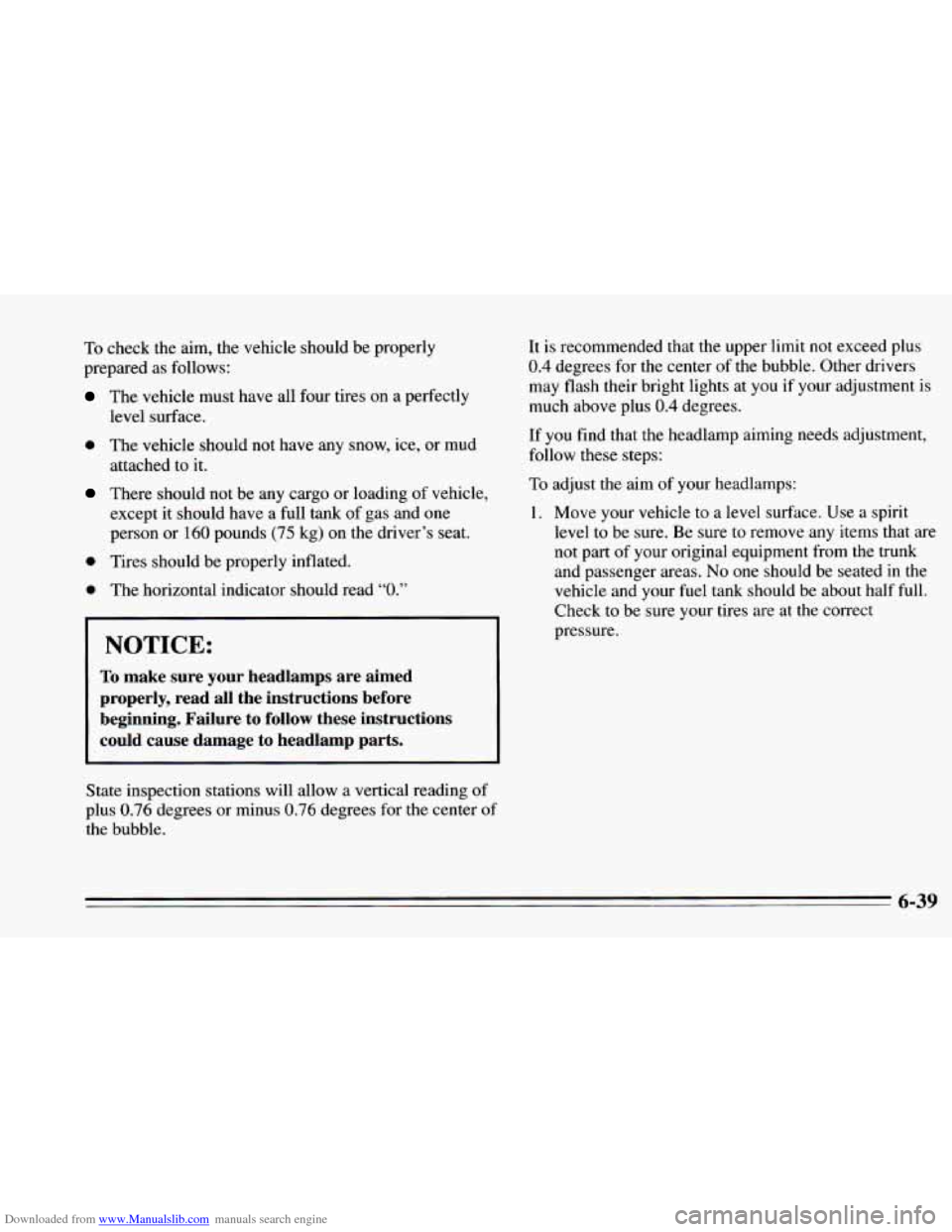
Downloaded from www.Manualslib.com manuals search engine To check the aim, the vehicle should be properly
prepared as follows:
The vehicle must have all four tires on a perfectly
level surface.
0 The vehicle should not have any snow, ice, or mud
There should not be any cargo or loading of vehicle,
except it should have a full tank of gas and one
person or
160 pounds (75 kg) on the driver’s seat.
attached to
it.
0 Tires
should be properly inflated.
0 The horizontal indicator should read “0.”
I NOTICE:
To make sure your headlamps are aimed
properly, read all the instructions before
beginning. Failure to
follow these instructions
could cause damage to headlamp parts.
State inspection stations will allow a vertical reading of
plus
0.76 degrees or minus 0.76 degrees for the center of
the bubble. It
is recommended that the upper limit not exceed plus
0.4 degrees for the center of the bubble. Other drivers
may flash their bright lights at you if your adjustment is
much above plus
0.4 degrees.
If you find that the headlamp aiming needs adjustment,
follow these steps:
To adjust the aim of your headlamps:
1. Move your vehicle to a level surface. Use a spirit
level to be sure. Be sure to remove any items that are
not part of your original equipment from the trunk
and passenger areas.
No one should be seated in the
vehicle and your fuel tank should be about half full.
Check to be sure your tires are at the correct
pressure.
6-39
Page 281 of 388
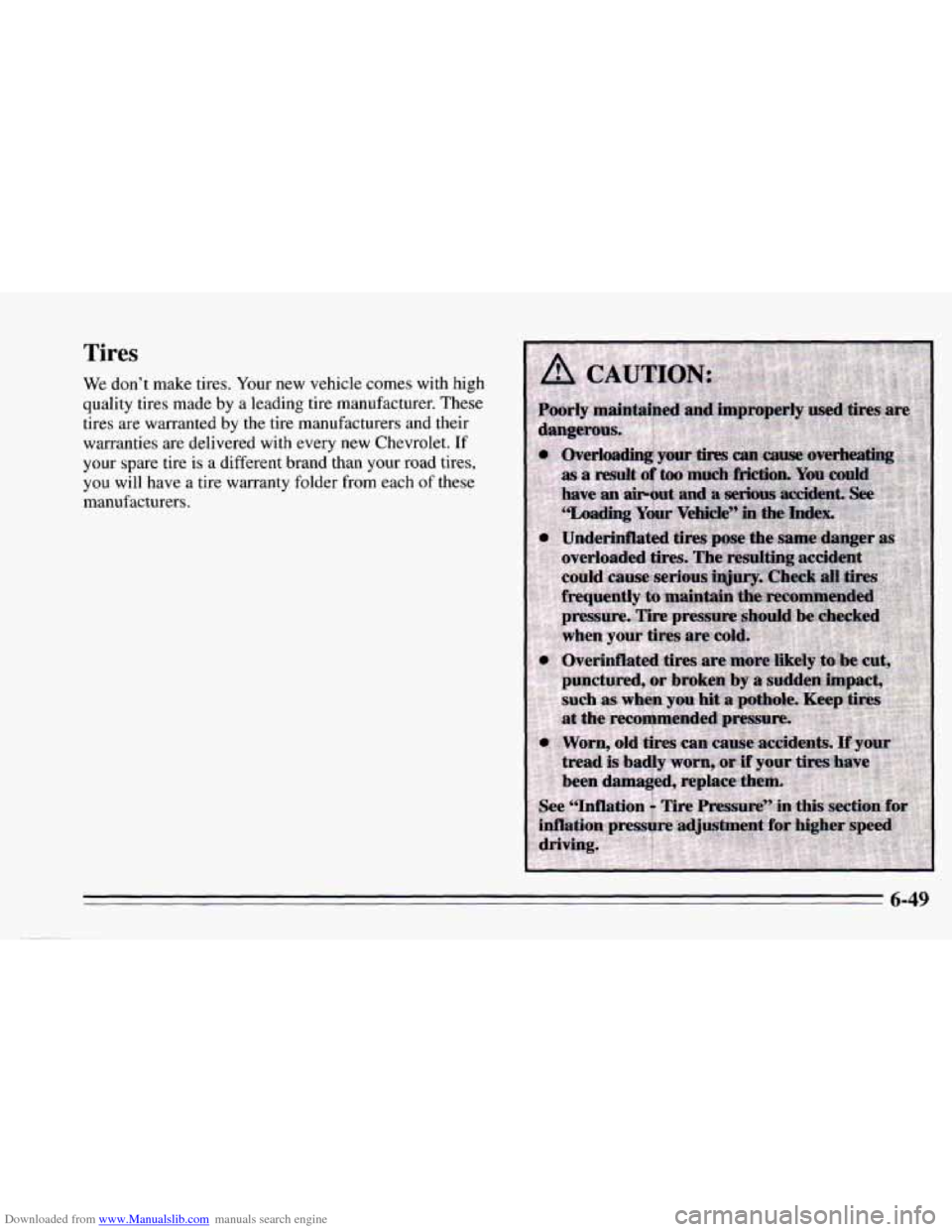
Downloaded from www.Manualslib.com manuals search engine Tires
We don’t make tires. Your new vehicle comes with high
quality tires made by a leading tire manufacturer. These
tires are warranted by the tire manufacturers and their
warranties are delivered with every new Chevrolet. If
your spare tire is a different brand than
your road tires,
you will have a tire warranty folder from each of these
manufacturers.
6-49
Page 282 of 388

Downloaded from www.Manualslib.com manuals search engine Inflation - Tire Pressure
The Tire-Loading Information label which is on the
driver’s door shows the correct inflation pressures for
your tires, when they’re cold. “Cold” means your
vehicle has been sitting for at least three hours or driven
no
more than a mile.
If you’ll be driving at speeds higher than 100 mph
(160 kmk) where it is legal, raise the “cold” inflation
pressure of each tire to
35 psi (240 kPa). When you end
this very high speed driving, reduce the “cold” inflation
pressures to those listed on the Tire-Loading
Information Label.
NOTICE:
Don’t let anyone tell you that underinflation or
overinflation is all right. It’s not. If your tires
don’t have enough air (underinflation) you can
get:
Too much flexing
Too much heat
Tire overloading
Bad wear
0 Bad handling
Bad fuel economy.
If your tires have too much air (overinflation),
you can get:
Unusual wear
Bad handling
Rough ride
Needless damage from road hazards.
6-50
Page 283 of 388
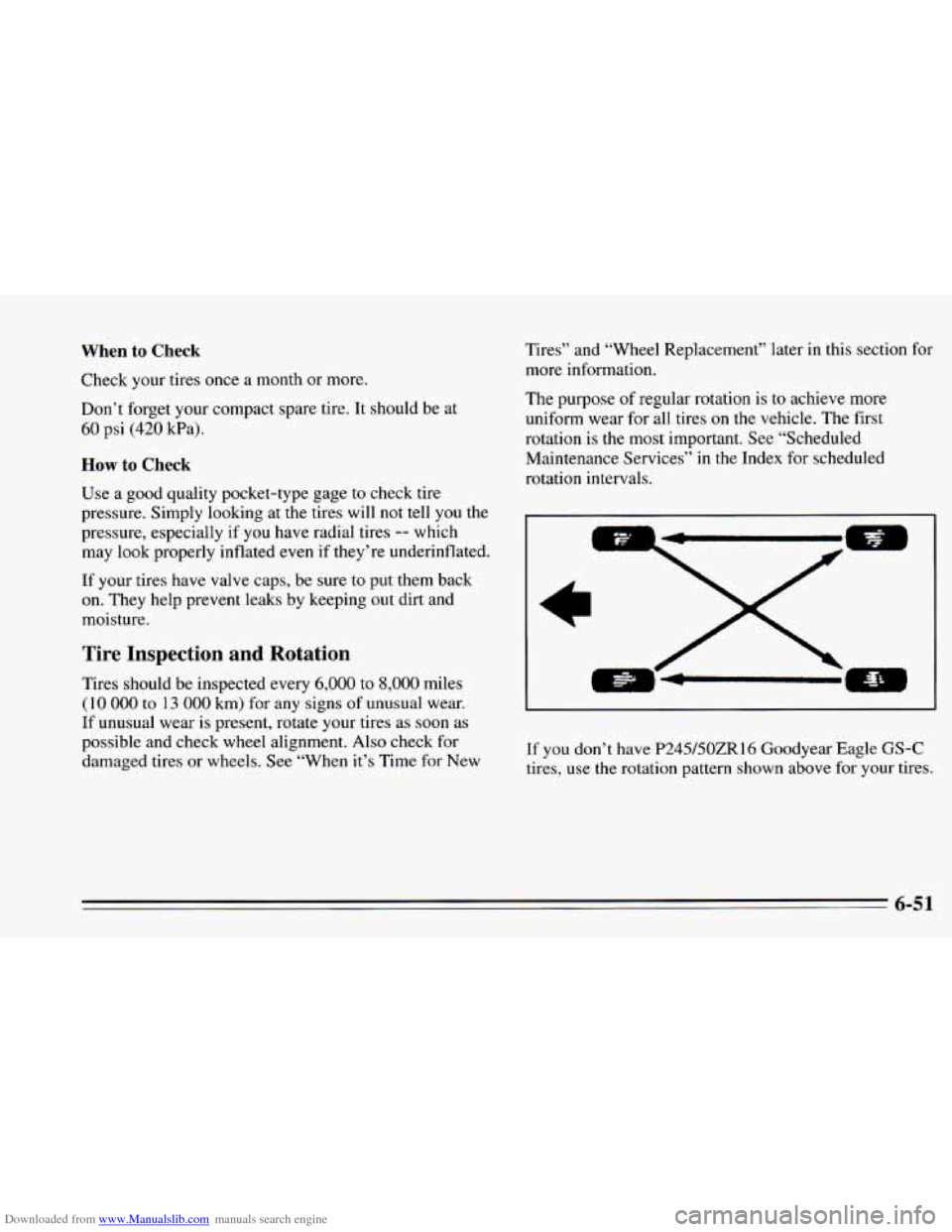
Downloaded from www.Manualslib.com manuals search engine When to Check
Check your tires once a month or more.
Don’t forget your compact spare tire. It should be at
60 psi (420 kPa).
DW to Check
use a good quality pocket-type gage to check tire
pressure. Simply looking at the tires will not tell you the
pressure, especially if you have radial tires
-- which
may look properly inflated even if they’re underinflated.
If your tires have valve caps, be sure to put them back
on. They help prevent leaks by keeping out dirt and
moisture.
Tire Inspection and Rotation
Tires should be inspected every 6,000 to 8,000 miles
(1 0 000 to 13 000 km) for any signs of unusual wear.
If unusual wear is present, rotate your tires as soon as
possible and check wheel alignment. Also check for
damaged tires or wheels. See “When it’s Time
for New Tires”
and “Wheel Replacement” later
in this section for
more information.
The purpose
of regular rotation is to achieve more
uniform wear for all tires on the vehicle. The first
rotation
is the most important. See “Scheduled
Maintenance Services”
in the Index for scheduled
rotation intervals.
-7 [*
If you don’t have P245/5OZR16 Goodyear Eagle GS-C
ires, use the rotation pattern shown above for your tires.
6-51
Page 284 of 388
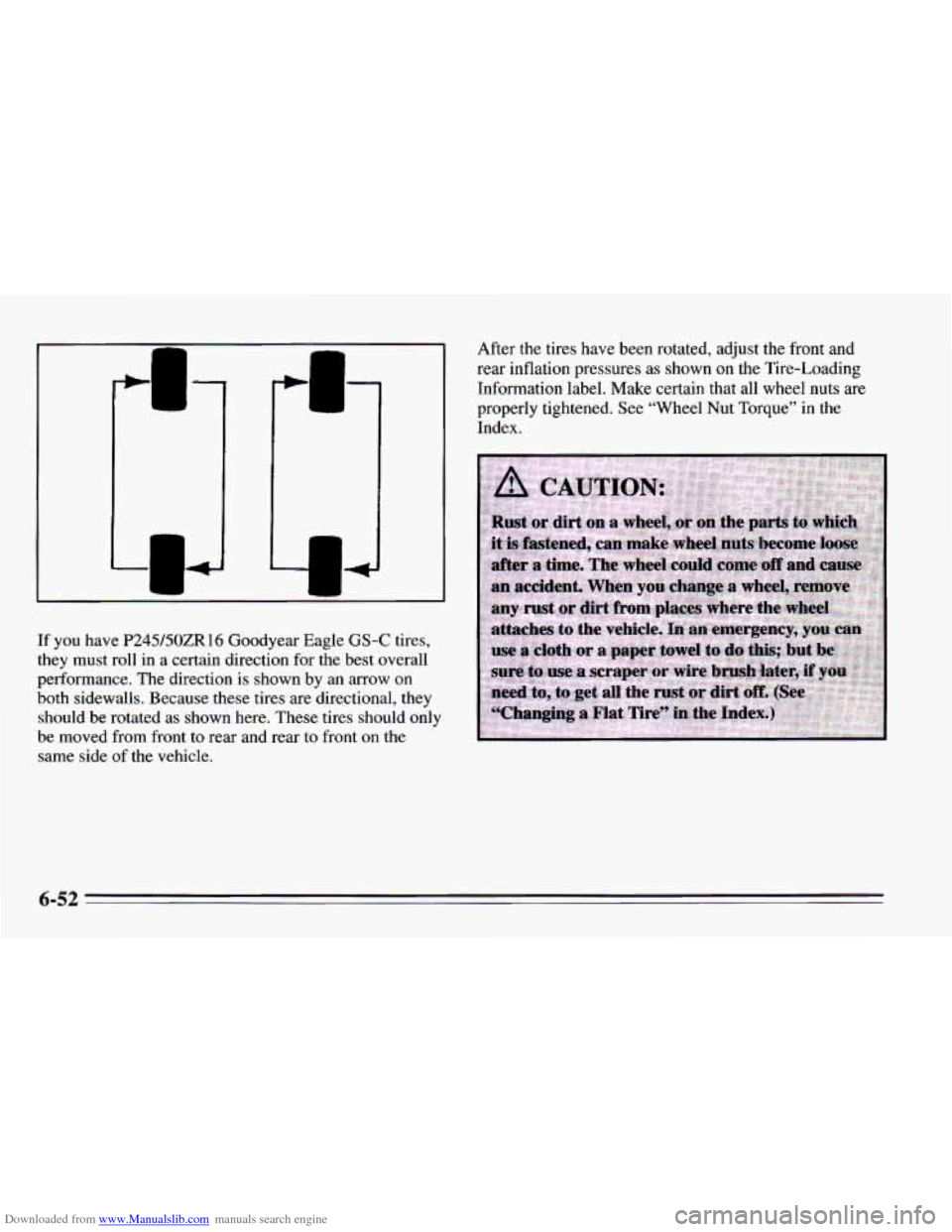
Downloaded from www.Manualslib.com manuals search engine LIJ
If you have P245/50ZR 16 Goodyear Eagle GS-C tires,
they must roll
in a certain direction for the best overall
performance. The direction
is shown by an arrow on
both sidewalls. Because these tires are directional, they
should be rotated as shown here. These tires should only
be moved from front to rear and rear to front on the
same side
of the vehicle. After the
tires
have been rotated, adjust the front and
rear inflation pressures as shown
on the Tire-Loading
Information label.
Make certain that all wheel nuts are
properly tightened. See “Wheel Nut Torque” in the
Index.